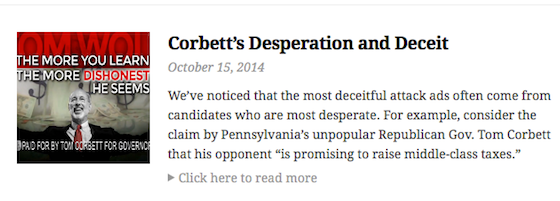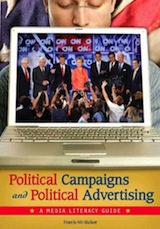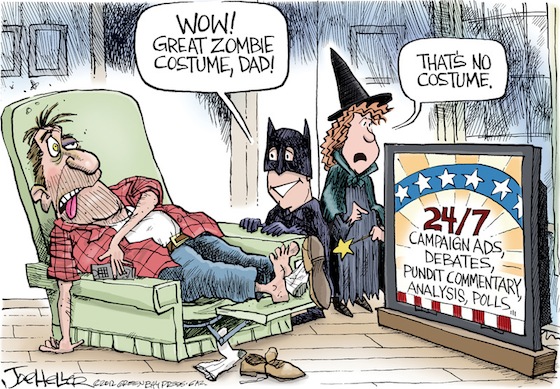Campaign Ads: Helping Students Find the Truth
 By Frank W. Baker
By Frank W. Baker
You’ve seen them on television— political campaign commercials— and you probably wanted to throw something at the TV. They’re seemingly everywhere on every network channel and during every part of the day and night.
Yes, even in this multimedia Internet age with social media at everyone’s fingertips, advertising by politicians on television has not gone out of style.

Now here is something most students don’t know: campaign ads are considered “free speech,” and thus cannot be edited, censored or blocked. Given this amount of leeway, political candidates will (and do) say anything (even outright lies) in their ads.
So how are students supposed to know what to believe? More about that in a moment.
Why teach with & about political ads?
Advertising surrounds us and these persuasive political messages ramp up around primary and general election time in every year candidates run for office. If students aren’t educated to see through these slickly produced commercials, they’re bound to believe much of what they see and hear.
When we teach our students to carefully dissect these types of ads, we help them to develop the kind of critical thinking and viewing skills that produce savvy if skeptical citizens.
The new Common Core (ELA) standards recognize advertising messages in references to text as argument — emphasizing a focus on purposes, techniques and audiences. The National Social Studies standards also make references to the evolving role of media in society as well as how advertising and social media have become key parts of the political process.
With a multitude of ads being posted on YouTube, as well as being broadcast on television and cable, accessing these messages for teaching purposes is easier than ever. Most of these ads are 30 seconds (or less) in length, so they’re prefect for playback, for close reading and for analysis and deconstruction.
Deconstructing a political ad
Several years ago, I created an advertising worksheet designed to aid teachers who wanted their students to recognize all of the elements that go into making a commercial and learn to appreciate the techniques of manipulation involved, including the everpresent appeals to emotion.
Students also need to understand and study the “language of the moving image” — both the tools (camera, lighting, sound) and techniques (music, symbolism, color, etc.) that are used to create the ad package.
In this worksheet, found on the elections section of my website, students are asked to consider:
► The type of ad (is it biographical, negative, warm & fuzzy, etc.)

► The key images (who is the candidate seen with; what colors or symbols are being prominently displayed?)
► The sounds (does the ad feature music? If so how does it affect how the message might be received?)
► The themes (every ad has a theme, even a title—can you tell what it is)
► The words on the screen & in the voiceover (who is quoted; where do the “facts and figures” originate?; could they be misinterpreted?)
Try this teaching approach:
Record a 30 second ad, or download one from the web. Show it to students once; next introduce the worksheet; then play the ad again, assigning students one of the focuses on the worksheet; then have them report their findings.
In my work with students, I find that giving them something specific to pay attention to makes it easier for them to analyze and comment thoughtfully.
How to know what to believe?
If politicians have a “license to lie” in campaign advertising, how are we supposed to know who and what to believe?
For several years now, newspapers and broadcast agencies have started to run “fact check” columns on what politicians say in their ads. (Check your local newspaper or TV station to determine if they’re offering this service.)
These journalism organizations, which are attached to commercial enterprises, realized at some point that after taking millions of dollars for advertising (and not challenging the veracity of the spots), it was their responsibility to investigate everything in the ads and report their findings. So fact checking was born.
The “fact checkers” can’t block the advertising, but they can break down the words, images and claims in the ads and report on what they find. And it’s not just ads; some groups investigate speeches and more.
Students could be challenged not only to watch a candidate’s ad, but also investigate the claims in the ad. And part of that research should include a review of the “fact checkers.”

FactCheck.org (Annenberg Public Policy Center – click above to see example)
Politifact.com (Tampa (FL) Times newspaper)
WashingtonPost Factchecker
FlackCheck.org (A Project of Annenberg Classroom) uses parody and humor to debunk false political advertising.
It’s a never-ending story
When the mid-term elections are history, news about campaigns and campaign ads won’t be over. Soon it will all begin again. Engaging your students in considering political advertising and the impact it has on our democracy and their future will continue to be important educational work.




































Local TV still rules for election ad spending
Local TV stations are reaping the dividends from the fight over control of the U.S. Senate, with ads for Senate contests up 12% over the 2010 midterms as part of a projected record $2.4 billion political ad spend. “Advertisers want to go where the eyeballs and ears are. There is a tendency for people who watch local news to be more likely to vote,” said NAB spokesman Dennis Wharton.
http://www.washingtonpost.com/business/technology/with-political-ads-expected-to-hit-a-record-news-stations-can-hardly-keep-up/2014/10/31/84a9e4b4-5ebc-11e4-9f3a-7e28799e0549_story.html
Corporate Media Companies Are the Real Winners in the 2014 Midterms http://www.thenation.com/blog/187665/corporate-media-companies-are-real-winners-2014-midterms
Because my students are of voting age, I delay detailed analysis of political advertising until after the election. My students don’t understand why it’s legal to lie in political ads. A Federal Judge has ruled political advertising is protected “free speech.” They can’t understand why a detergent maker can be punished for an ad that lies but not a politician. It’s a good discussion topic.
http://www.politico.com/blogs/under-the-radar/2014/09/judge-strikes-down-ohio-law-on-election-lies-195333.html